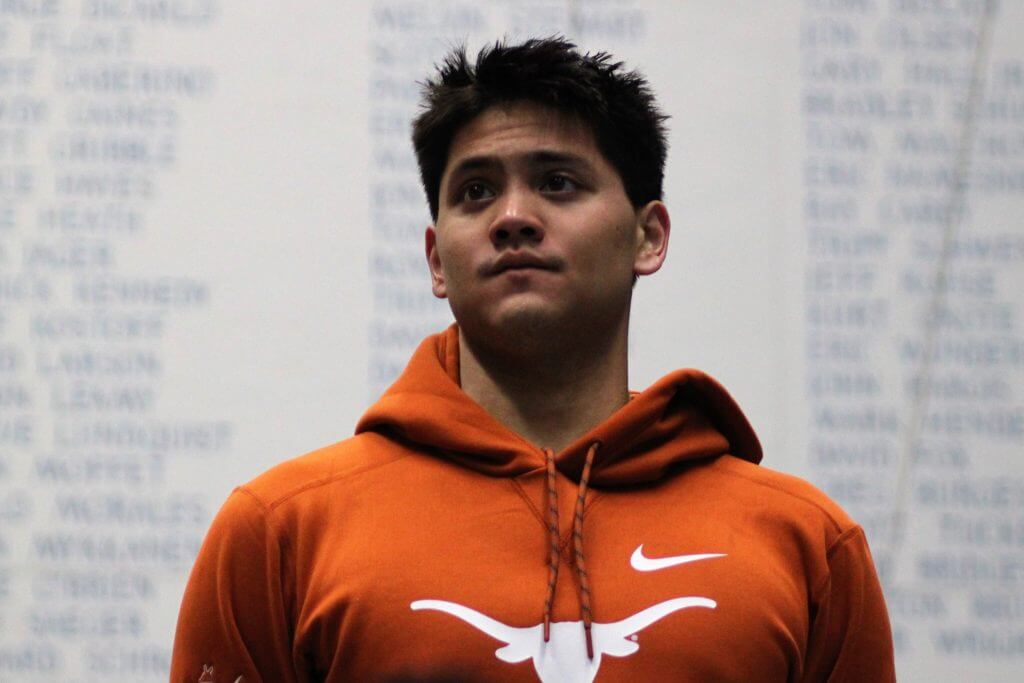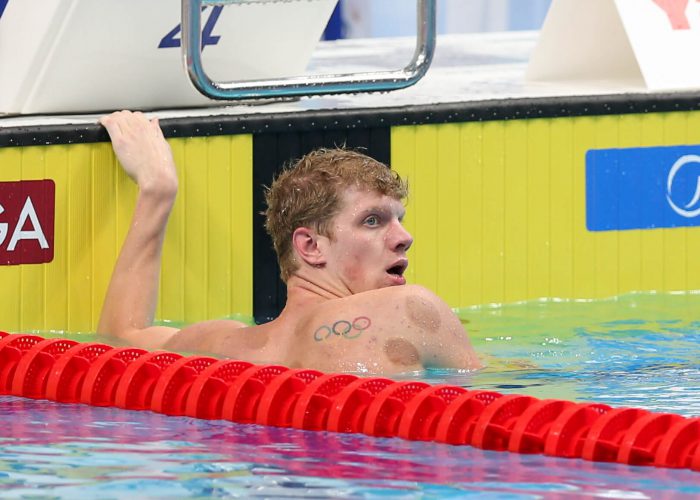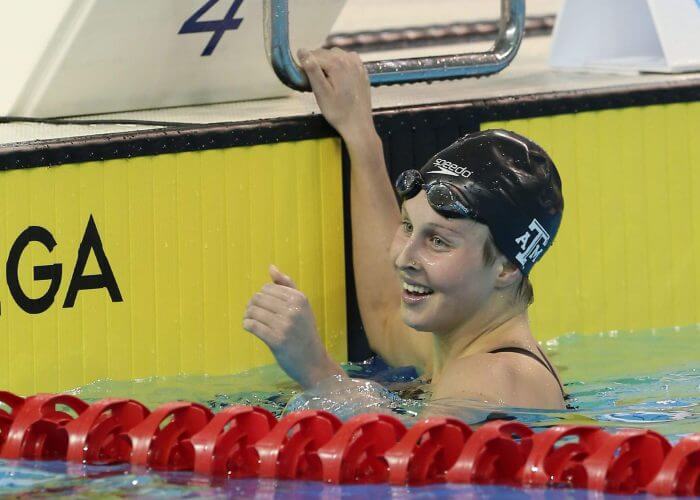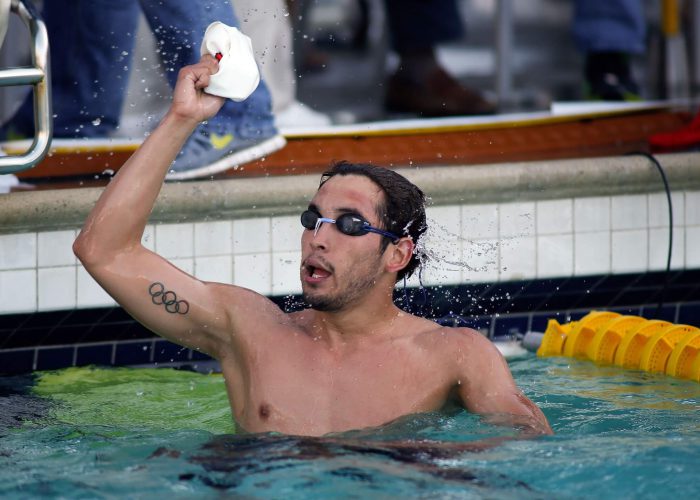NCAA Swimming Notes: Are Texas Men in Trouble?

By David Rieder.
The Texas men, dominant winners of the last three NCAA swimming and diving titles, lost each of their first three meets this season. After falling to Florida and Indiana in a three-team tri-meet, the Longhorns lost meets at Texas A&M and then at NC State before finally knocking off North Carolina this past weekend. So what’s wrong with Texas?
Probably not as much as it seems. Some teams just don’t swim very fast in October or November, and over the years, Eddie Reese’s squads have often fit that mold. Just last season, the team had lost to Indiana and to NC State by the time Thanksgiving rolled around.
How did that season turn out? Texas scored 542 points come March at the NCAA championships in Indianapolis, and the runner-up Cal Bears scored 349.
This year? A coach at a Power-Five university wrote in a text message that “Texas could be the first team to start 0-4 and win a national championship.” This is not college football, where a regular season loss or two kills a team’s championship aspirations. What does matter is that Texas still has swimmers of very strong pedigree.
Joseph Schooling did not swim against A&M but performed fine in the tri-meet and on the North Carolina road trip. Townley Haas has not been great, but he’s still the fastest man ever in the 200 free and no one else in NCAA swimming has ever been under 4:09 in the 500 free. On top of those two, the Longhorns still have John Shebat, a contender to win NCAA titles in the backstrokes.

Townley Haas — Photo Courtesy: SIPA USA
If Schooling, Haas and Shebat swim well in March—expect that they will—and the Longhorns get small contributions from the likes of Brett Ringgold and Jonathan Roberts, they’re among a small handful of teams capable of challenging for a championship.
But there’s one key weakness the Longhorns still have to figure out. Clark Smith graduates? Texas still has Haas. Jack Conger is gone? There’s Schooling. Will Licon, though? His absence leaves a hole in breaststroke.
Licon won the NCAA title in the 200 breast each of the last three years and added a 100 breast title his senior year while providing key legs on Texas’ medley relays. So far this year, Texas’ top breaststroker has been Ryan Harty, a redshirt sophomore who missed all of last season with injury.
And on Texas’ official roster, Harty’s event is listed as “backstroke.” Indeed, as a freshman in 2016, Harty finished seventh at the NCAA championships in the 200 back and made B-finals in both IM events.
Against both NC State and UNC, Harty was out-split by a full second on the breaststroke leg of the 200 medley relay. Reese has tried inserting Schooling into that spot but typically needs the Olympic gold medalist on the butterfly leg instead.
The Longhorns could probably live without individual breaststroke points at the NCAA championships, but for medley relay purposes, they need to find an answer here—or risk getting stuck in B-finals. But even after Texas’ rough start to the season, that’s the only major long-term concern.
Stacking Up the Aggies
It’s no secret that the Texas A&M women are a powerhouse—third at NCAAs last year and a couple of individual medals at the World Championships—but after the win over Texas, the Aggie men might also be worth watching come March.
First, the women. Bethany Galat won a silver in the 200 breast in Budapest, and Sydney Pickrem took bronze in the 400 IM after having to withdraw during the 200 IM final earlier in the week.
Even with Sarah Gibson and Ashley McGregor graduated, the Aggies are a well-rounded team—outside of the 200 breast, where their presence is conspicuous.

Sydney Pickrem — Photo Courtesy: Scott Grant/Swimming Canada
At the Texas dual meet—when the A&M women lost a narrow 151.5-148.5 decision—five Aggies were 2:12 or better in the 200 breast: Pickrem, Anna Belousova, Jorie Caneta, Galat and Esther Gonzalez. Yes, that’s after graduating an NCAA A-finalist in McGregor.
All five of those women rank in the top 11 in the country this year. Those faster include five women who put on tech suits for either the USA College Challenge or SMU Classic and Lilly King. Not bad.
A&M also has a 16-year-old on its team: Jing Wen Quah, whose brother Zheng Wen Quah swims for Cal and was the runner-up in the 200 fly at NCAAs last year. Jing isn’t too shabby either: despite being almost two years younger than anyone else on the team, she won the 100 fly against Texas.
Now for the men, who after beating Texas will have to contend with a deep SEC that saw four men’s teams finished in the top ten at last year’s NCAA championships. After third-place Florida, Georgia took eighth, Missouri was ninth and Alabama 10th. Auburn just missed, finishing 12th.
Texas A&M was well back of that, finishing 16th, but there’s an opportunity to move up this season and maybe even crack the top ten. It won’t hurt that some of conference rivals lost some big names—Chase Kalisz for Georgia, Michael Chadwick and Fabien Schwingenschlogl for Missouri—that should lead to some drop-off.
The Aggie men don’t have the deepest of rosters, but Mauro Castillo should be considered a favorite for the NCAA title in the 200 breast, and Jonathan Tybur should also score some big breaststroke points. Brock Bonetti will need to deliver in the backstrokes, and more consistent relay scoring—the team had just B-final relays last year—would help, too.
Watch Out For…
During his first two years at Alabama, Laurent Bams has twice been a B-finalist in the 100 free at the NCAA championships, and he’s contributed key relay legs for a pair of top-ten-finishing Crimson Tide squads. He’s versatile, too, and on Alabama’s official roster, his specialty is listed as “freestyle/butterfly/backstroke.”
Well, Bams is currently the No. 3-ranked 100 breaststroker in the country at 53.40, behind only Indiana’s Ian Finnerty and Cal’s Connor Hoppe.
Elsewhere in the SEC, Tennessee’s Erika Brown was a relay-only swimmer at the NCAA championships as a freshman. She now ranks third in the country in the 100 fly, after recording a 52.61 in the event against Louisville.
In the ACC, Notre Dame has put up an impressive start to the season, sweeping both Louisville and Georgia Tech before the Irish women got the better of Indiana this week. Sophomore Abbie Dolan has been the leading force for the women’s success, with strong dual meet efforts throughout the sprint free and relay events.
Dolan ranks seventh in the country in both the 100 and 200 so far this season, at 48.94 in the 100 and 1:45.94 in the 200. In the 200, only two swimmers have been quicker in a dual meet setting: reigning NCAA co-champions Katie Ledecky (1:44.51) and Mallory Comerford (1:45.20).
Some others who did not score individually at NCAAs last year and their current top-five national rankings:
- Khader Baqlah (Florida), 1:35.56 in 200 free (fifth)
- Tess Cieplucha (Tennessee), 4:11.22 in 400 IM (fifth)
- Caitlin Cooper (Virginia), 22.22 in women’s 50 free (fourth)
- Kyle Decoursey (Tennessee), 19.66 in men’s 50 free (fifth)
- Katie Grover (UCLA), 52.29 in women’s 100 fly (second)
About the Mile
Remember that 1650 free from the men’s NCAA championships last year? Pretty hard to forget, since four guys went head-to-head for 66 laps and all ended up going faster than any man ever had before.
Well, two of those four men graduated, as did two others from the top nine. It’s tough to know yet what sort of encore performance will be in store for this season, especially since so few distance swimmers have even raced a 1650 yet.

Marcelo Acosta — Photo Courtesy: Stan Szeto/USA Today Sports
But Louisville’s Marcelo Acosta has, and he owns the top time in the country by 25 seconds. At the Cardinal’s tri-meet with Virginia and Princeton tri-meet, swimmers put on tech suits for the mile only, and Acosta managed a time of 14:45.42, only six seconds slower than he swam on his way to a tenth-place finish at NCAAs last year.
For his career, Acosta has a best time of 14:33.68, ranking him 21st all-time in the event. His competition on the college level this year includes No. 2 Felix Auboeck (Michigan), No. 3 Akram Mahmoud (South Carolina), No. 19 P.J. Ransford (Michigan) and No. 24 Anton Ipsen (NC State).
Maybe four guys won’t break last year’s record—14:22.41—but it could still be a doozy.




Texas calls it “Rocktober” and “Slowvember” for a reason. Any decent coach knows to train hard to build the base in the early half of the season then you tune and go hard on speed after. The teams resting are in trouble, not Texas
Don’t forget Soxtember!
Do you even swim?
Once upon a time in a place not so washed up
P
Amazing that a 16 year old Chinese exchange student could academically be prepared for a US college. Even without the time required for swimming. She must be a brilliant student. And of course athlete
No. They will still go really fast at NCAAs if they are healthy.